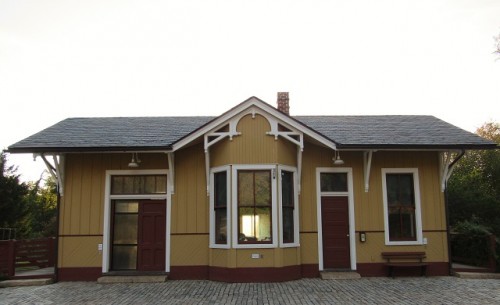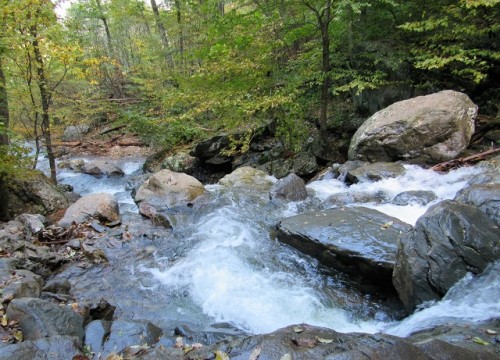Day 6: Friday, October 9, 2015
Monticello is one of the big attractions in Virginia – the home of our nation’s third President, Thomas Jefferson. After making our way from Appomattox Court House, we were ready to start our visit!
We got our tickets, and then got some lunch. The café at Monticello had a pretty decent selection of salads and sandwiches – Jon and I both got chef salads for $5.99 each. Then we took the little shuttle bus up the hill (you can also walk, but the ticket seller said it was confusing to find the trail – we found out later it isn’t confusing, you just cross the street…).
Once up at the top, we had a little bit of time before we needed to queue up for our tour. With a bit of patience, I was able to get a couple of photos of the front of Monticello with no one in them! We also wandered around the back and saw the back lawn and the flowers planted around the edges of the lawn.

The front of Monticello – with me!

The side view of Monticello – looking at the Greenhouse

A Monarch Butterfly at Monticello

I loved these flowers – Cockscomb at Monticello
Monticello was built beginning in 1768 – Jefferson had inherited the land from his father. It was built in stages, and he lived in the south wing at the beginning while the rest of the house was being built, with a combination of skilled artisans and slave labor. Jefferson married after he started building the home, and eventually had 6 children. Sadly, only two children survived beyond the first couple of years. His wife died young as well, shortly after the birth of their sixth child. Jefferson was devastated.

The back of Monticello
Jefferson was a true Renaissance man, with interests ranging from religion to agriculture to science. He invented several items, including a bookstand that works like a lazy susan, so you could turn it to the book you wanted to read. Perfect for someone like me – I always have multiple books going at one time! He designed the house himself, and it had some interesting features, like beds built into the wall, to save space and keep them warmer, and a wine dumbwaiter built into the dining room that allowed slaves to deliver wine right up to the table. Jefferson liked to have private conversations over dinner, and didn’t want slaves to serve the dinner and overhear.

Jefferson had the weathervane on top of the house connected to this compass, so he could easily see from the porch the direction of the wind.
Jefferson’s home also had a very interesting feature – the front foyer of the home was created as a museum exhibit for visitors to the home. The room was a two story octagonal room with displays from Jefferson’s collections. He collected art, Native American artifacts, and natural history items like fossils. For many people visiting, this would have been their first time seeing some of these types of items.
Jefferson died in the home on July 4, 1826, just hours before his long-time friend and some-time rival, John Adams. Interesting that both men died on the 50th anniversary of the independence of the nation they helped to establish!
The tour didn’t have a lot of formal narrative explaining about Jefferson and the home. I would have preferred more of this overview, but our docent was happy to answer questions about the items in the home, and she explained which items belonged to Jefferson, and which were period.

One of the beautiful brick outbuildings at Monticello
After the guided tour of the home, you could wander around at your leisure to see other places. At Monticello, what was typically housed in outbuildings was built underneath the main home. The wine cellar, beer cellar, some of the slave quarters, stables, and kitchen were all open and available for a self-tour. It was interesting to see a stove that separated out the main stove into several “burners” allowing dishes to be cooked at different temperatures, by controlling the size of the individual fires underneath.

The kitchen at Monticello – on the left are individual “burners” – each had a separate fire beneath to control the temperature of the that burner.
We also listened to an optional (and free) 45 minute slave tour, which gave an overview of the lives of slaves on the plantation. Over the course of his life, Jefferson owned over 600 slaves. They worked cultivating the land, or in various industries; Jefferson’s nails were used to build things throughout the region. Sometimes he let slaves sell the crops that they grew on their own time or carpentry work that they did, and allowed them to keep their money.
Interestingly, the docent was pretty candid about Sally Hemings’ connection to Jefferson; since the DNA test in the 1990s, most historians have come around to believe that Jefferson most likely did maintain a long term relationship with his slave, and almost certainly fathered several of her children. Of course, what remains lost to time is whether Sally was a willing participant.

A reconstructed slave cabin at Monticello
Jefferson was a great man, but he did have his flaws. Although he sometimes purchased slaves to unite families, there were times where he sold troublesome slaves, and like most of the founding fathers, he freed very few slaves when he died. Just five slaves got their freedom in his will. He had also accumulated significant debt, meaning that his heirs had to sell Monticello to settle his estate.
Fortunately for us, Mr. Uriah P. Levy purchased the home not long after it was sold by the Jefferson family. Levy admired Jefferson, and did his best to maintain the home as Jefferson would have wanted. The Levy’s owned the home for nearly 100 years, before it came under the control of the Thomas Jefferson Foundation in 1923, the non-profit organization that currently owns the home.
If you visit, consider walking back to the Visitor’s Center – it is less than a half a mile, and takes you by the Jefferson family cemetery on the way. What an amazing visit!

Thomas Jefferson’s grave – apparently throwing money on it is a thing.
Driving Distance for Day 6: 115 miles – Lynchburg, VA – Appomattox Court House NHP – Monticello – Waynesboro, VA
Hotel for the Night: Super 8, Waynesboro. Clean but dated, and it was in an awkward location that required a U-Turn at a traffic light on a main street. The toilet would also run at intervals – kind of annoying! It wasn’t cheap, but it was half of what the available hotels in Charlottesville were running. I’m not sure if Charlottesville is always really expensive, or if there was some sort of event going on that weekend. And it was quiet, and Jon and I were able to take a three hour nap the next afternoon when our colds got us too far down to keep touristing…
Travel Tips: Monticello is popular, so it’s got all of the frustrations too – big parking lot with tons of cars, a sterile, movie theater style ticket station, big tour groups and timed entry. Pack your patience… We were there on a Friday, so it wasn’t too terrible, but it was still busy.
Tickets – Monticello: The most expensive of the trip, at $25 per person. However, the guidebook was a screaming deal at $3! The lady working in the store showed me and another woman that you could either buy the full sized guidebook (about 10” x 10”) for full price (I think it was $13) or pay $3 for a tall, skinny book. Granted, the pictures aren’t as nice in the tall, skinny version, but the text was exactly the same – and you can just buy postcards to supplement the book and get the photos you want. I appreciated the tip!

















































